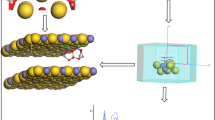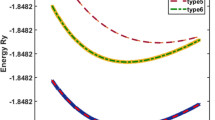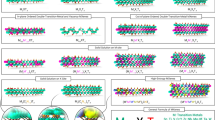Abstract
We study the electromechanical response of Janus transition metal dichalcogenide (TMD) nanotubes from first principles. In particular, considering both armchair and zigzag variants of 18 select Janus TMD nanotubes that are identified as stable, we determine the change in bandgap and charge carriers’ effective mass upon (tensile) axial and torsional deformations using density functional theory (DFT). We observe that metallic nanotubes remain unaffected, whereas the bandgap in semiconducting nanotubes decreases linearly and quadratically with axial and shear strains, respectively, leading to semiconductor–metal transitions. In addition, we find that there is a continuous decrease and increase in the effective mass of holes and electrons with strains, respectively, leading to n-type–p-type semiconductor transitions. We show that this behavior is a consequence of the rehybridization of orbitals, rather than charge transfer between the atoms. Overall, mechanical deformations form a powerful tool for tailoring the electronic response of semiconducting Janus TMD nanotubes.
Graphical abstract






Similar content being viewed by others
Data availability
The data associated with this work can be found in the Supplementary material.
References
S. Iijima, Helical microtubules of graphitic carbon. Nature 354(6348), 56–58 (1991)
R. Tenne, Advances in the synthesis of inorganic nanotubes and fullerene-like nanoparticles. Angew. Chem. Int. Ed. 42(42), 5124–5132 (2003)
C.N.R. Rao, M. Nath, Advances in Chemistry: A Selection of CNR Rao’s Publications (1994–2003) (World Scientific, New Jersey, 2003), pp. 310–333
M. Serra, R. Arenal, R. Tenne, An overview of the recent advances in inorganic nanotubes. Nanoscale 11(17), 8073–8090 (2019)
S. Haastrup, M. Strange, M. Pandey, T. Deilmann, P.S. Schmidt, N.F. Hinsche, M.N. Gjerding, D. Torelli, P.M. Larsen, A.C. Riis-Jensen et al., The computational 2D materials database: high-throughput modeling and discovery of atomically thin crystals. 2D Mater. 5(4), 042002 (2018)
J Zhou, L Shen, M D Costa, K A Persson, Shyue P Ong, P Huck, Y Lu, X Ma, Y Chen, H Tang, et al. 2DMatPedia, an open computational database of two-dimensional materials from top-down and bottom-up approaches. Scientific Data, 6(1):1–10, 2019
M.N. Gjerding, A. Taghizadeh, A. Rasmussen, S. Ali, F. Bertoldo, T. Deilmann, U.P. Holguin, N.R. Knøsgaard, M. Kruse, S. Manti et al., Recent progress of the computational 2D materials database (C2DB). 2D Mater. 8(4), 044002 (2021)
S. Kumar, P. Suryanarayana, Bending moduli for forty-four select atomic monolayers from first principles. Nanotechnology 31(43), 43LT01 (2020)
M. Yagmurcukardes, Y. Qin, S. Ozen, M. Sayyad, F.M. Peeters, S. Tongay, H. Sahin, Quantum properties and applications of 2D Janus crystals and their superlattices. Appl. Phys. Rev. 7(1), 011311 (2020)
Q.-L. Xiong, J. Zhou, J. Zhang, T. Kitamura, Z.-H. Li, Spontaneous curling of freestanding Janus monolayer transition-metal dichalcogenides. Phys. Chem. Chem. Phys. 20(32), 20988–20995 (2018)
A. Bhardwaj, P. Suryanarayana, Elastic properties of Janus transition metal dichalcogenide nanotubes from first principles. Eur. Phys. J. B 95(13), 1–8 (2022)
A.-Y. Lu, H. Zhu, J. Xiao, C.-P. Chuu, Y. Han, M.-H. Chiu, C.-C. Cheng, C.-W. Yang, K.-H. Wei, Y. Yang et al., Janus monolayers of transition metal dichalcogenides. Nat. Nanotechnol. 12(8), 744–749 (2017)
J. Zhang, S. Jia, I. Kholmanov, L. Dong, D. Er, W. Chen, H. Guo, Z. Jin, V.B. Shenoy, L. Shi et al., Janus monolayer transition-metal dichalcogenides. ACS Nano. 11(8), 8192–8198 (2017)
D.B. Trivedi, G. Turgut, Y. Qin, M.Y. Sayyad, D. Hajra, M. Howell, L. Liu, S. Yang, N.H. Patoary, H. Li et al., Room-temperature synthesis of 2D Janus crystals and their heterostructures. Adv. Mater. 32(50), 2006320 (2020)
Y.-C. Lin, C. Liu, Y. Yu, E. Zarkadoula, M. Yoon, A.A. Puretzky, L. Liang, Y. Kong, X. Gu, A. Strasser et al., Low energy implantation into transition-metal dichalcogenide monolayers to form Janus structures. ACS Nano. 14(4), 3896–3906 (2020)
Z.-K. Tang, B. Wen, M. Chen, L.-M. Liu, Janus MoSSe nanotubes: tunable band gap and excellent optical properties for surface photocatalysis. Adv. Theory Simul. 1(10), 1800082 (2018)
S. Oshima, M. Toyoda, S. Saito, Geometrical and electronic properties of unstrained and strained transition metal dichalcogenide nanotubes. Phys. Rev. Mater. 4(2), 026004 (2020)
S. Xie, H. Jin, Y. Wei, S. Wei, Theoretical investigation on stability and electronic properties of Janus MoSSe nanotubes for optoelectronic applications. Optik 227, 166105 (2021)
L. Ju, P. Liu, Y. Yang, L. Shi, G. Yang, L. Sun, Tuning the photocatalytic water-splitting performance with the adjustment of diameter in an armchair WSSe nanotube. J. Energy Chem. 61, 228–235 (2021)
L. Ju, J. Qin, G. Shi, L. Yang, J. Zhang, L. Sun, Rolling the WSSe bilayer into double-walled nanotube for the enhanced photocatalytic water-splitting performance. Nanomaterials 11(3), 705 (2021)
S. Zhang, H. Jin, C. Long, T. Wang, R. Peng, B. Huang, Y. Dai, MoSSe nanotube: a promising photocatalyst with an extremely long carrier lifetime. J. Mater. Chem. A 7(13), 7885–7890 (2019)
D Yudilevich, R Levi, I Nevo, R Tenne, A Ya’akobovitz, and E Joselevich. Self-Sensing Torsional Resonators Based on Inorganic Nanotubes. ICME, pp. 1–4 (2018)
R. Levi, J. Garel, D. Teich, G. Seifert, R. Tenne, E. Joselevich, Nanotube electromechanics beyond carbon: the case of \({\text{ WS }}_{2}\). ACS Nano. 9(12), 12224–12232 (2015)
Y. Divon, R. Levi, J. Garel, D. Golberg, R. Tenne, A. Ya’akobovitz, E. Joselevich, Torsional resonators based on inorganic nanotubes. Nano Lett. 17(1), 28–35 (2017)
S. Barua, H.S. Dutta, R. Gogoi, S. Devi, R. Khan, Nanostructured \({\text{ MoS }}_{2}\)-based advanced biosensors: a review. ACS Appl. Nano Mater. 1(1), 2–25 (2017)
B.L. Li, J. Wang, H.L. Zou, S. Garaj, C.T. Lim, J. Xie, N.B. Li, D.T. Leong, Low-dimensional transition metal dichalcogenide nanostructures based sensors. Adv. Func. Mater. 26(39), 7034–7056 (2016)
V. Sorkin, H. Pan, H. Shi, S.Y. Quek, Y.W. Zhang, Nanoscale transition metal dichalcogenides: structures, properties, and applications. Crit. Rev. Solid State Mater. Sci. 39(5), 319–367 (2014)
M. Nath, S. Kar, A.K. Raychaudhuri, C.N.R. Rao, Superconducting \({\text{ NbSe }}_{2}\) nanostructures. Chem. Phys. Lett. 368(5–6), 690–695 (2003)
T. Tsuneta, T. Toshima, K. Inagaki, T. Shibayama, S. Tanda, S. Uji, M. Ahlskog, P. Hakonen, M. Paalanen, Formation of metallic \({\text{ NbSe }}_{2}\) nanotubes and nanofibers. Curr. Appl. Phys. 3(6), 473–476 (2003)
H.-H. Wu, Q. Meng, H. Huang, C.T. Liu, X.-L. Wang, Tuning the indirect-direct band gap transition in the \({\text{ MoS }}_{2-{\text{ x }}}{\text{ Se }}_{\text{ x }}\) armchair nanotube by diameter modulation. Phys. Chem. Chem. Phys. 20(5), 3608–3613 (2018)
A.E.G. Mikkelsen, F.T. Bölle, K.S. Thygesen, T. Vegge, I.E. Castelli, Band structure of MoSTe Janus nanotubes. Phys. Rev. Mater. 5(1), 014002 (2021)
W. Zhao, Y. Li, W. Duan, F. Ding, Ultra-stable small diameter hybrid transition metal dichalcogenide nanotubes X-M-Y (X, Y= S, Se, Te; M= Mo, W, Nb, Ta): a computational study. Nanoscale 7(32), 13586–13590 (2015)
L. Tao, Y.-Y. Zhang, J. Sun, S. Du, H.-J. Gao, Band engineering of double-wall Mo-based hybrid nanotubes. Chin. Phys. B 27(7), 076104 (2018)
R.A. Evarestov, A.V. Kovalenko, A.V. Bandura, First-principles study on stability, structural and electronic properties of monolayers and nanotubes based on pure \({\text{ Mo(W)S(Se) }}_{2}\) and mixed (Janus)Mo(W)SSe dichalcogenides. Physica E 115, 113681 (2020)
F.T. Bölle, A.E.G. Mikkelsen, K.S. Thygesen, T. Vegge, I.E. Castelli, Structural and chemical mechanisms governing stability of inorganic Janus nanotubes. NPJ Comput. Mater. 7(1), 1–8 (2021)
Y.Z. Wang, R. Huang, B.L. Gao, G. Hu, F. Liang, Y.L. Ma, Mechanical and strain-tunable electronic properties of Janus MoSSe nanotubes. Chalcogenide Lett. 15(11), 535–543 (2018)
Y.F. Luo, Y. Pang, M. Tang, Q. Song, M. Wang, Electronic properties of Janus MoSSe nanotubes. Comput. Mater. Sci. 156, 315–320 (2019)
P. Hohenberg, W. Kohn, Inhomogeneous electron gas. Phys. Rev. 136(3B), B864 (1964)
W. Kohn, L.J. Sham, Self-consistent equations including exchange and correlation effects. Phys. Rev. 140(4A), A1133 (1965)
X. Gonze, J.-M. Beuken, R. Caracas, F. Detraux, M. Fuchs, G.-M. Rignanese, L. Sindic, M. Verstraete, G. Zerah, F. Jollet et al., First-principles computation of material properties: the abinit software project. Comput. Mater. Sci. 25(3), 478–492 (2002)
K. Momma, F. Izumi, VESTA: a three-dimensional visualization system for electronic and structural analysis. J. Appl. Crystallogr. 41(3), 653–658 (2008)
A. Sharma, P. Suryanarayana, Real-space density functional theory adapted to cyclic and helical symmetry: application to torsional deformation of carbon nanotubes. Phys. Rev. B 103(3), 035101 (2021)
Q. Xu, A. Sharma, B. Comer, H. Huang, E. Chow, A.J. Medford, J.E. Pask, P. Suryanarayana, SPARC: simulation package for ab-initio real-space calculations. SoftwareX 15, 100709 (2021)
S. Ghosh, P. Suryanarayana, SPARC: accurate and efficient finite-difference formulation and parallel implementation of density functional theory: Isolated clusters. Comput. Phys. Commun. 212, 189–204 (2017)
S. Ghosh, P. Suryanarayana, SPARC: accurate and efficient finite-difference formulation and parallel implementation of density functional theory: extended systems. Comput. Phys. Commun. 216, 109–125 (2017)
S. Ghosh, A.S. Banerjee, P. Suryanarayana, Symmetry-adapted real-space density functional theory for cylindrical geometries: application to large group-IV nanotubes. Phys. Rev. B 100(12), 125143 (2019)
A.S. Banerjee, P. Suryanarayana, Cyclic density functional theory: a route to the first principles simulation of bending in nanostructures. J. Mech. Phys. Solids 96, 605–631 (2016)
David Codony, Irene Arias, Phanish Suryanarayana, Transversal flexoelectric coefficient for nanostructures at finite deformations from first principles. Phys. Rev. Mater. 5(3), L030801 (2021)
S. Kumar, D. Codony, I. Arias, P. Suryanarayana, Flexoelectricity in atomic monolayers from first principles. Nanoscale 13(3), 1600–1607 (2021)
A. Bhardwaj, A. Sharma, P. Suryanarayana, Torsional moduli of transition metal dichalcogenide nanotubes from first principles. Nanotechnology 32(28), 28LT02 (2021)
A. Bhardwaj, A. Sharma, P. Suryanarayana, Torsional strain engineering of transition metal dichalcogenide nanotubes: an ab initio study. Nanotechnology 32(47), 47LT01 (2021)
J.P. Perdew, K. Burke, M. Ernzerhof, Generalized gradient approximation made simple. Phys. Rev. Lett. 77(18), 3865 (1996)
D.R. Hamann, Optimized norm-conserving Vanderbilt pseudopotentials. Phys. Rev. B 88(8), 085117 (2013)
M.F. Shojaei, J.E. Pask, A.J. Medford, P. Suryanarayana. SPMS: Table of transferable and soft ONCV pseudopotentials (in preparation)
J. Heyd, G.E. Scuseria, M. Ernzerhof, Hybrid functionals based on a screened Coulomb potential. J. Chem. Phys. 118(18), 8207–8215 (2003)
W. Shi, Z. Wang, Mechanical and electronic properties of Janus monolayer transition metal dichalcogenides. J. Phys. Condens. Matter 30(21), 215301 (2018)
I. Kaplan-Ashiri, R. Tenne, Mechanical properties of \({\text{ WS }}_{2}\) nanotubes. J. Cluster Sci. 18(3), 549–563 (2007)
I. Kaplan-Ashiri, S.R. Cohen, K. Gartsman, V. Ivanovskaya, T. Heine, G. Seifert, I. Wiesel, H.D. Wagner, R. Tenne, On the mechanical behavior of \({\text{ WS }}_{2}\) nanotubes under axial tension and compression. Proc. Natl. Acad. Sci. 103(3), 523–528 (2006)
K.S. Nagapriya, O. Goldbart, I. Kaplan-Ashiri, G. Seifert, R. Tenne, E. Joselevich, Torsional stick-slip behavior in \({\text{ WS }}_{2}\) nanotubes. Phys. Rev. Lett. 101(19), 195501 (2008)
E.D. Minot, Y. Yaish, V. Sazonova, J.-Y. Park, M. Brink, P.L. McEuen, Tuning carbon nanotube band gaps with strain. Phys. Rev. Lett. 90(15), 156401 (2003)
N. Zibouche, M. Ghorbani-Asl, T. Heine, A. Kuc, Electromechanical properties of small transition-metal dichalcogenide nanotubes. Inorganics 2(2), 155–167 (2014)
W. Li, G. Zhang, M. Guo, Y.-W. Zhang, Strain-tunable electronic and transport properties of \({\text{ MoS }}_{2}\) nanotubes. Nano Res. 7(4), 518–527 (2014)
M. Ghorbani-Asl, N. Zibouche, M. Wahiduzzaman, A.F. Oliveira, A. Kuc, T. Heine, Electromechanics in \({\text{ MoS }}_{2}\) and \({\text{ WS }}_{2}\): nanotubes vs. monolayers. Sci. Rep. 3, 2961 (2013)
Y.Z. Wang, R. Huang, X.Q. Wang, Q.F. Zhang, B.L. Gao, L. Zhou, G. Hua, Strain-tunable electronic properties of \({\text{ CrS }}_{2}\) nanotubes. Chalcogenide Lett. 13(7), 301–307 (2016)
G. Hautier, A. Miglio, G. Ceder, G.-M. Rignanese, X. Gonze, Identification and design principles of low hole effective mass p-type transparent conducting oxides. Nat. Commun. 4(1), 1–7 (2013)
T. Nilges, S. Lange, M. Bawohl, J.M. Deckwart, M. Janssen, H.-D. Wiemhöfer, R. Decourt, B. Chevalier, J. Vannahme, H. Eckert et al., Reversible switching between p-and n-type conduction in the semiconductor \({\text{ Ag }}_{10}{\text{ Te }}_{4}{\text{ Br }}_{3}\). Nat. Mater. 8(2), 101–108 (2009)
J. Zhang, P. Gu, G. Long, R. Ganguly, Y. Li, N. Aratani, H. Yamada, Q. Zhang, Switching charge-transfer characteristics from p-type to n-type through molecular doping (co-crystallization). Chem. Sci. 7(6), 3851–3856 (2016)
H. Hiramatsu, K. Ueda, H. Ohta, M. Hirano, M. Kikuchi, H. Yanagi, T. Kamiya, H. Hosono, Heavy hole doping of epitaxial thin films of a wide gap p-type semiconductor, LaCuOSe, and analysis of the effective mass. Appl. Phys. Lett. 91(1), 012104 (2007)
L. Chen, J. Yang, S. Klaus, L.J. Lee, R. Woods-Robinson, J. Ma, Y. Lum, J.K. Cooper, F.M. Toma, L.-W. Wang et al., p-Type transparent conducting oxide/n-type semiconductor heterojunctions for efficient and stable solar water oxidation. J. Am. Chem. Soc. 137(30), 9595–9603 (2015)
T. Wen, Y. Wang, N. Li, Q. Zhang, Y. Zhao, W. Yang, Y. Zhao, H.-K. Mao, Pressure-driven reversible switching between n-and p-Type conduction in chalcopyrite \({\text{ CuFeS }}_{2}\). J. Am. Chem. Soc. 141(1), 505–510 (2018)
B.D. Naab, S. Himmelberger, Y. Diao, K. Vandewal, P. Wei, B. Lussem, A. Salleo, Z. Bao, High mobility n-type transistors based on solution-sheared doped 6,13-Bis (triisopropylsilylethynyl) pentacene thin films. Adv. Mater. 25(33), 4663–4667 (2013)
R.F.W. Bader, T.T. Nguyen-Dang. In Advances in Quantum Chemistry, vol. 14. (Elsevier, 1981), pp. 63–124
W. Tang, E. Sanville, G. Henkelman, A grid-based bader analysis algorithm without lattice bias. J. Phys. Condens. Matter 21(8), 084204 (2009)
Acknowledgements
The authors gratefully acknowledge the support of the US National Science Foundation (CAREER-1553212).
Author information
Authors and Affiliations
Contributions
All of the authors contributed equally to this work.
Corresponding author
Supplementary Information
Below is the link to the electronic supplementary material.
Rights and permissions
About this article
Cite this article
Bhardwaj, A., Suryanarayana, P. Strain engineering of Janus transition metal dichalcogenide nanotubes: an ab initio study. Eur. Phys. J. B 95, 59 (2022). https://doi.org/10.1140/epjb/s10051-022-00319-8
Received:
Accepted:
Published:
DOI: https://doi.org/10.1140/epjb/s10051-022-00319-8




